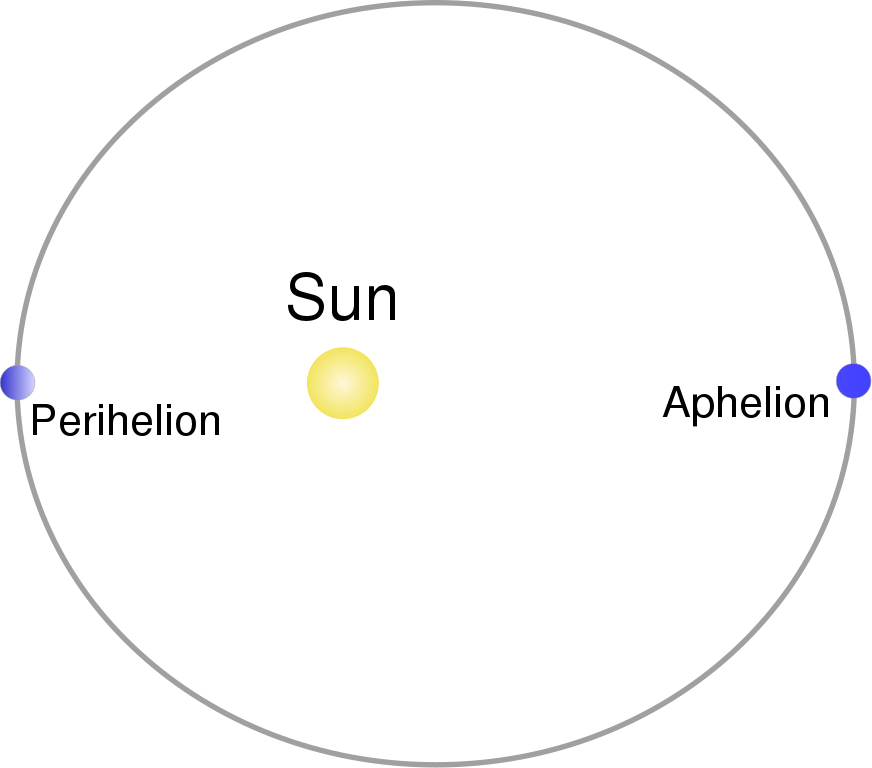Perihelion
The perihelion is the nearest point of a body's direct orbit around the Sun. The opposite, farthest point is called the aphelion.
Earth-Sun perihelion
Currently, the planet Earth reaches perihelion in early January, approximately 14 days after the December solstice. At perihelion, the Earth's center is about 0.98329 astronomical units (AU) or 147,098,070 km (91,402,500 mi) from the Sun's center. In contrast, the Earth reaches aphelion currently in early July, approximately 14 days after the June solstice. The aphelion distance between the Earth's and Sun's centers is currently about 1.01671 AU or 152,097,700 km (94,509,100 mi).
The dates of perihelion and aphelion change over time due to precession and other orbital factors, which follow cyclical patterns known as Milankovitch cycles. In the short term, such dates can vary up to 2 days from one year to another. This significant variation is due to the presence of the Moon: while the Earth–Moon barycenter is moving on a stable orbit around the Sun, the position of the Earth's center which is on average about 4,700 kilometers (2,900 mi) from the barycenter, could be shifted in any direction from it—and this affects the timing of the actual closest approach between the Sun's and the Earth's centers (which in turn defines the timing of perihelion in a given year).
Because of the increased distance at aphelion, only 93.55% of the radiation from the Sun falls on a given area of Earth's surface as does at perihelion, but this does not account for the seasons, which result instead from the tilt of Earth's axis of 23.4° away from perpendicular to the plane of Earth's orbit. Indeed, at both perihelion and aphelion it is summer in one hemisphere while it is winter in the other one. Winter falls on the hemisphere where sunlight strikes least directly, and summer falls where sunlight strikes most directly, regardless of the Earth's distance from the Sun.
In the northern hemisphere, summer occurs at the same time as aphelion, when solar radiation is lowest. Despite this, summers in the northern hemisphere are on average 2.3 °C (4 °F) warmer than in the southern hemisphere, because the northern hemisphere contains larger land masses, which are easier to heat than the seas.
Perihelion and aphelion do however have an indirect effect on the seasons: because Earth's orbital speed is minimum at aphelion and maximum at perihelion, the planet takes longer to orbit from June solstice to September equinox than it does from December solstice to March equinox. Therefore, summer in the northern hemisphere lasts slightly longer (93 days) than summer in the southern hemisphere (89 days).
Astronomers commonly express the timing of perihelion relative to the First Point of Aries, not in terms of days and hours, but rather as an angle of orbital displacement, the so-called longitude of the periapsis (also called longitude of the pericenter). For the orbit of the Earth, this is called the longitude of perihelion, and in 2000 it was about 282.895°; by 2010, this had advanced by a small fraction of a degree to about 283.067°.
For the orbit of the Earth around the Sun, the time of apsis is often expressed in terms of a time relative to seasons, since this determines the contribution of the elliptical orbit to seasonal variations. The variation of the seasons is primarily controlled by the annual cycle of the elevation angle of the Sun, which is a result of the tilt of the axis of the Earth measured from the plane of the ecliptic. The Earth's eccentricity and other orbital elements are not constant, but vary slowly due to the perturbing effects of the planets and other objects in the solar system (Milankovitch cycles).
On a very long time scale, the dates of the perihelion and of the aphelion progress through the seasons, and they make one complete cycle in 22,000 to 26,000 years. There is a corresponding movement of the position of the stars as seen from Earth, called the apsidal precession.
Calculating perihelion
Comparing osculating elements at a specific epoch to effectively those at a different epoch will generate differences. The time-of-perihelion-passage as one of six osculating elements is not an exact prediction (other than for a generic two-body model) of the actual minimum distance to the Sun using the full dynamical model. Precise predictions of perihelion passage require numerical integration.
Orbital elements such as the time of perihelion passage are defined at the epoch chosen using an unperturbed two-body solution that does not account for the n-body problem. To get an accurate time of perihelion passage you need to use an epoch close to the perihelion passage. For example, using an epoch of 1996, Comet Hale–Bopp shows perihelion on 1 April 1997. Using an epoch of 2008 shows a less accurate perihelion date of 30 March 1997.
Numerical integration shows dwarf planet Eris will come to perihelion around December 2257. Using an epoch of 2021, which is 236 years early, less accurately shows Eris coming to perihelion in 2260.
